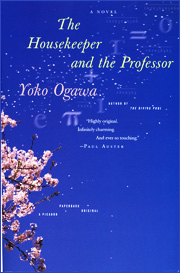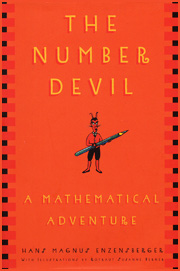Are
there an infinite number of Ruth-Aaron numbers?
|
Paul
Erdös (1913-1996) was one of the most prolific mathematicians of
all time, having authored over 1500 articles. An Erdös number
measures the shortest distance of a researcher from Erdös on a
graph whose edges represent co-authorship.

The
NCB thanks number theorist Chris Caldwell, University of Tennessee,
Martin,
for much of the above information. Carl Pomerance is now at
Dartmouth.
|
| Some numbers . . . .
Ruth-Aaron numbers are a pair of consecutive integers such that the sum of the prime factors of n and n + 1 are equal.
Examples:
| Counting distinct prime factors
only once: |
|
Prime Factors: |
|
Sum of Prime Factors:
|
5
and 6
|
|
5
2, 3 |
|
5 = 5
2 + 3 = 5
|
24 and 25
|
|
2, 3
5
|
|
2 + 3 = 5
5 = 5
|
49
and 50
|
|
7
2, 5
|
|
7 = 7
2 + 5 = 7 |
77 and 78
|
|
7, 11
2, 3, 13 |
|
7 + 11 = 18
2 +3 +13 = 18 |
104
and 105
|
|
2, 13
3, 5, 7
|
|
2 + 13 = 15
3 + 5 + 7 = 15
|
153
and 154
|
|
3, 17
2, 7, 11
|
|
3 + 17 = 20
2 + 7 +11 = 20
|
369 and 370
|
|
3, 41
2, 5, 37 |
|
3 + 41 = 44
2 + 5 + 37 = 44
|
492 and 493
|
|
2, 3, 41
17, 29 |
|
2 + 3 + 41 = 46
17 + 29 = 46
|
| 714 and 715
|
|
2, 3, 7, 17
5, 11, 13 |
|
2+3 +7 +17 = 29
5 + 11 + 13 = 29
|
and for more examples . . . .
|
|
and with repeated prime factors - - -
more
Ruth-Aaron pairs
|
|
8 and 9 |
|
2, 2, 2,
3, 3 |
|
2 + 2 + 2 = 6
3 + 3 = 6 |
|
15 and 16 |
|
3, 5
2, 2, 2, 2 |
|
3 + 5 = 8
2 + 2 + 2 + 2 = 8 |
Ruth-Aaron triplets
when counting repeated prime factors
|
|
41762
41763
41764
|
|
2, 3, 251, 277
17, 53, 463
2, 2, 11, 19,
499
|
|
2 +3 + 251 + 277 = 533
17 + 53 + 463
= 533
2 + 2 + 11 +
19 + 499= 533
|
|
|
|
|
|
|
References
P. Erdös
and C. Pomerance, On the largest prime factors of n and n + 1,
Aequations
Mathematicae 17, (1978, 311-321.
|
C. Nelson, D.
E. Penny and C. Pomerance, 714 and 715, J.
Recreational Math., 7, (1974), 87-89.
|
C.
Pomerance, Ruth-Aaron Numers Revisited, Paul Erdös and
His Mathematic I, Budapest 2002, pp. 567-579,
Mathematical Studies, 11, Bolyai Society.
|
| A. Schnizel
and W. Sierpinski, Sur certaines hypothèses concernant les
nombres premiers. Remarque, Acta
Arithm. 4, 185-208, 1958. |
|
|
Significance
of Deposit #95: "The Housekeeper and the Professor"
Obviously,
many people of all ages and cultures have come to appreciate statistics
through a love of the game of baseball. In a very subtle manner
the Japanese writer Yoko Ogawa uses baseball, number theory and
struggles in life to form a common bond among three individuals - a
memory impaired professor, a housekeeper and the housekeeper's
illegitimate ten-year-old son.
There are numerical bonds other than Ruth-Aaron pairs. To quote Katharine
Ott's review in Science (vol.
324, June 5, 2009), Ogawa's narrative "blossoms in the passages
describing the Housekeeper's journey into mathematics." Ogawa uses birthdays to
remind math readers of the Pythagorean/Euclidean interest in amicable
numbers. She links human traits and emotions with perfect, deficient
and abundant numbers. She indirectly reminds
readers of basic questions often attributed to Descartes. "Math
has proven the existence of God because it is absolute and without
contradiction; but the devil must exist as well, because we cannot
prove it."
|
For several years Chris K.
Caldwell of the University of Tennessee, Martin, has created and
maintained an indispensable web site on prime number theory. The
NCB was lucky to have had his timely Deposit # 19 on
twin primes. organizer
George Woltman. He reported the forty-second Mersenne prime with the
work being verified by Tony Reix. This prime has 7,816,230
digits, the largest of any type, and may be expressed as
|
The NCB recommends the following sources
. . .
|
. . . on Primes and Mersenne Primes
|
|
| How Many Primes Are There?
See < http://primes.utm.edu/howmany.shtml
> |
| Frequently Asked Questions about
Prime Numbers. See <
http://primes.utm.edu/notes/faq/ > |
| What are the first twenty largest
known "twin primes?" See <
http://www.research/primes/largest.html#twin > |
See GIMPS' < http://www.mersenne.org >
and Focus, The Newsletter of the
Mathematical Association of America, vol. 24, February, 2004, p. 4.
|
Jeffrey J. Wanko, "The Legacy of
Marin Mersenne," Mathematics Teacher,
vol. 98, No. 8, April, 2005, pp. 525-529.
|
| and from the BBC News on April 4,
2003, see <
http://news.bbc.co.uk/2/hi/science/nature/2911945.stm > |
|
. . . and on Ruth-Aaron pairs.
|
|
| What are the ten largest
known "Ruth-Aaron" pairs? See <
http://www.research.att.com/~njas/sequences/A006145 > |
| What are "Ruth-Aaron"
triplets? See <
http://en.wikipedia.org/wiki/Ruth-Aaron_pair > |
What is in the research
literature? See <
http://mathworld.wolfram.com/Ruth-AaronPair.html >
|
Books you will
enjoy . . . .
|

|
|
"And
when he (the Professor) noticed that his seat number was 714 and Root's
was 715, he began to lecture again and completely forgot to sit down."
Yoko Ogawa in her widely acclaimed
The Housekeeper and the Professor," Picador, 2009.
(Translated from the Japanese.)
|
|
|

|
"There's no
such thing as a number devil."
"Is that so? How can you be speaking to me if I don't exist?"
Hans Magnus Enzensberger in his best selling The Number Devil: A Mathematical Adventure.
Metropolitan Books, Hold and Co., 1997.
(Translated from the German.) |
|
|
|

|
|
|